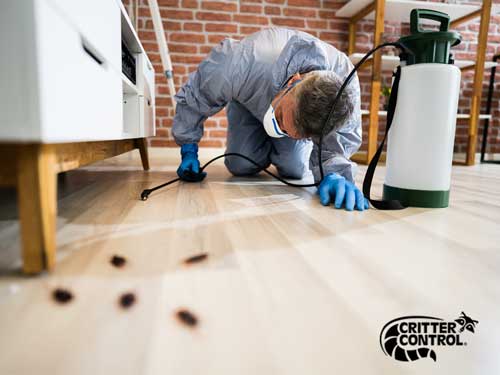Specialist A1 Charlotte Bed Bug Exterminator - Top Quality Solution Ensured
Specialist A1 Charlotte Bed Bug Exterminator - Top Quality Solution Ensured
Blog Article
Bed Pest Therapy Failure: Comparing Chemical Vs. Non-Chemical Solutions
In the realm of insect control, specifically when handling the relentless concern of bed insects, the option in between chemical and non-chemical treatment remedies can be a crucial one. Both approaches supply distinct advantages and disadvantages, influencing aspects such as performance, safety and security factors to consider, and general price. By examining the nuanced details of each method, a clearer understanding of which course to pursue in dealing with a bed insect problem can be achieved.
Effectiveness of Chemical Treatments
Chemical treatments for bed insect invasions have been extensively recognized for their powerful and fast effectiveness in eliminating these parasites. When thinking about the effectiveness of chemical treatments, it is crucial to understand that they can offer a quick and thorough solution to a bed bug issue.
Additionally, chemical therapies have the benefit of providing residual effects, suggesting that they can remain to remove bed insects also after the preliminary application. This residual action is especially useful in combating any prospective re-infestations. Furthermore, the rapid action of chemical therapies can bring alleviation to individuals dealing with serious bed bug problems, allowing them to reclaim control of their home swiftly.
Safety And Security Problems With Chemical Solutions
One critical element that needs careful consideration when utilizing chemical options for bed bug therapy is making certain the safety and security of owners and the setting. Direct exposure to particular chemicals used in bed bug treatments can lead to breathing issues, skin irritability, or other damaging responses, especially in people with pre-existing conditions or level of sensitivities.
Additionally, the ecological impact of chemical options is another substantial factor to consider. Some chemicals utilized in bed insect therapies might be damaging to advantageous insects, wild animals, and ecological communities if they seep into the dirt or water systems. It is essential to use chemical therapies deliberately, complying with safety standards, and taking into consideration much less poisonous alternatives to alleviate these threats and make certain the risk-free and efficient administration of bed insect infestations.
Benefits of Non-Chemical Approaches
Considering the potential safety and security issues and ecological influence linked with chemical solutions for bed pest treatment, discovering non-chemical techniques presents an appealing choice with a number of distinctive advantages. Non-chemical methods provide a safer alternative for houses, specifically those with youngsters, animals, or people sensitive to extreme chemicals. These methods remove the dangers of direct exposure to toxic compounds, minimizing the capacity for damaging wellness results. Furthermore, non-chemical treatments are environmentally pleasant, as they do not add to air or water air pollution, making them a sustainable selection for insect control.
Additionally, non-chemical solutions can be efficient in targeting bed bugs, including hard-to-reach locations where chemical therapies may not pass through blog - A1 pest control services charlotte. Methods such as warmth therapy, vacuuming, heavy steam cleansing, and cushion coverings supply comprehensive removal without the usage of hazardous chemicals.
Limitations of Non-Chemical Treatments

Furthermore, non-chemical treatments commonly require several applications to accomplish successful eradication. This can be taxing and might not always guarantee full removal of all bed pests and their eggs, especially in hidden or hard-to-reach places.
Moreover, the success of non-chemical treatments heavily relies on proper implementation and thoroughness, which can be challenging for people without professional experience. Insufficient application of non-chemical methods may lead to incomplete eradication, leading to persistent invasions and the requirement for extra treatments.
As a result, while non-chemical therapies have their benefits, it is important to acknowledge these limitations and consider them when establishing the most effective approach for managing bed bug infestations.
Cost Contrast: Chemical Vs. Non-Chemical Options
Offered the constraints associated with non-chemical treatments, an important facet to assess in the context of bed pest management is the expense comparison between chemical and non-chemical alternatives. In contrast, non-chemical therapies like warmth treatment or vapor can be more pricey, with costs ranging from $1,000 to $6,000 for a whole home. While the initial expense of chemical therapies may seem reduced, numerous treatments might be needed to totally get rid of the invasion, potentially increasing the total cost.
Verdict

Taking into consideration the prospective security problems and environmental impact connected with chemical options for bed pest therapy, exploring non-chemical techniques provides an appealing choice with several distinctive advantages.Offered the constraints linked with non-chemical treatments, a necessary aspect to examine in the context of bed pest management is the price contrast between chemical and non-chemical choices. In contrast, non-chemical treatments like warmth treatment or vapor can be a lot more expensive, with expenses ranging from $1,000 to $6,000 More about the author for a whole home. While the initial expense of chemical treatments might appear lower, several treatments might be required to fully eradicate the infestation, potentially boosting the overall expense.In verdict, when comparing chemical and non-chemical bed insect treatment choices, it is vital to take into consideration performance, safety, advantages, restrictions, and cost.
Report this page